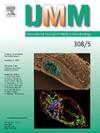Characterization of carbapenem-resistant Klebsiella pneumoniae from blood cultures in Gaza Strip hospitals, Palestine
IF 3.6
3区 医学
Q1 MICROBIOLOGY
引用次数: 0
Abstract
Background
Carbapenem-resistant Klebsiella pneumoniae (CRKP) is a difficult to treat organism owing to limited therapeutic options. So far, little is known about the molecular characteristics of CRKP in Palestine.
Objectives
The aim of this study was to investigate the antimicrobial resistance patterns, multilocus sequence types (ST) and resistance genes among clinical K. pneumoniae isolates from hospitalized patients in Gaza Strip, Palestine.
Methods
K. pneumoniae from blood cultures (n = 55) were collected at two hospitals in Gaza Strip (2023) and identified by MALDI-TOF-MS. Antimicrobial susceptibility testing was done using VITEK-2 automated systems. Carbapenemases were phenotypically detected. Whole genome sequencing (WGS) of all CRKP isolates was performed to assess determinants for carbapenem resistance and genotypes.
Results
Of all K. pneumoniae isolates, 40 % (n = 22/55) were CRKP. Among CRKP, cefiderocol showed the least resistance (46 %, n = 10/22) while ceftazidime/avibactam showed a synergistic effect with aztreonam (36 %, n = 8/22). The majority (86 %, n = 19/22) of CRKP carried metallo-β-lactamases, and only 9 % (n = 2/22) encoded OXA-48 carbapenemase. WGS of CRKP revealed that the predominant genotype is multilocus sequence type ST147 harboring blaNDM-5 and blaCTX-M-15.
Conclusion
The proportion of CRKP among all K. pneumoniae from bloodstream infection in Gaza Strip is high (40 %) and mainly associated with the blaNDM-5-positive high-risk clone ST147.
巴勒斯坦加沙地带医院血液培养中碳青霉烯耐药肺炎克雷伯菌的特征
背景:耐碳青霉烯肺炎克雷伯菌(CRKP)是一种难以治疗的有机体,由于有限的治疗方案。迄今为止,对巴勒斯坦地区CRKP的分子特征知之甚少。目的:研究巴勒斯坦加沙地带住院患者肺炎克雷伯菌临床分离株的耐药模式、多位点序列类型(ST)和耐药基因。方法:于2023年在加沙地带两家医院采集血培养物(n = 55)中的肺炎克雷伯菌,采用MALDI-TOF-MS进行鉴定。采用VITEK-2全自动系统进行药敏试验。碳青霉烯酶表型检测。对所有CRKP分离株进行全基因组测序(WGS),以评估碳青霉烯类耐药性和基因型的决定因素。结果:40 % (n = 22/55)的肺炎克雷伯菌分离株为CRKP。在CRKP中,头孢地罗耐药最少(46 %,n = 10/22),而头孢他啶/阿维巴坦与氨曲南有协同作用(36 %,n = 8/22)。大多数(86 %,n = 19/22)的CRKP携带金属β-内酰胺酶,只有9 % (n = 2/22)的CRKP携带OXA-48碳青霉烯酶。WGS结果显示,CRKP的优势基因型为多位点序列型ST147,包含blaNDM-5和blaCTX-M-15。结论:CRKP在加沙地带所有肺炎克雷伯菌血液感染中所占比例较高(40 %),主要与blandm -5阳性高危克隆ST147相关。
本文章由计算机程序翻译,如有差异,请以英文原文为准。
求助全文
约1分钟内获得全文
求助全文
来源期刊
CiteScore
9.70
自引率
0.00%
发文量
18
审稿时长
45 days
期刊介绍:
Pathogen genome sequencing projects have provided a wealth of data that need to be set in context to pathogenicity and the outcome of infections. In addition, the interplay between a pathogen and its host cell has become increasingly important to understand and interfere with diseases caused by microbial pathogens. IJMM meets these needs by focussing on genome and proteome analyses, studies dealing with the molecular mechanisms of pathogenicity and the evolution of pathogenic agents, the interactions between pathogens and host cells ("cellular microbiology"), and molecular epidemiology. To help the reader keeping up with the rapidly evolving new findings in the field of medical microbiology, IJMM publishes original articles, case studies and topical, state-of-the-art mini-reviews in a well balanced fashion. All articles are strictly peer-reviewed. Important topics are reinforced by 2 special issues per year dedicated to a particular theme. Finally, at irregular intervals, current opinions on recent or future developments in medical microbiology are presented in an editorial section.

 求助内容:
求助内容: 应助结果提醒方式:
应助结果提醒方式:


